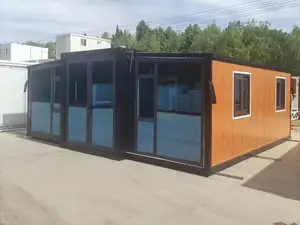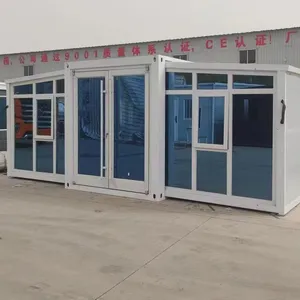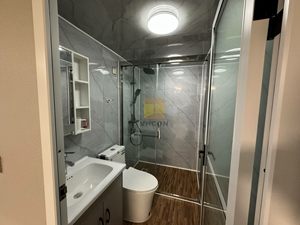(112716 products available)















































 Ready to Ship
Ready to Ship












































































































































































A 20ft expandable container home is a housing solution that can be built using one or more 20ft container boxes. A standard 20ft container home size is approximately 20 feet in length, 8 feet in width, and 8.6 feet in height. However, expandable container homes have expandable walls or can be stacked on top of each other to create a larger living space.
There are several types of 20ft expandable container homes, including:
Single Expandable Container Home
A single expandable container home is the most basic type. It consists of one container box that can be expanded to create more space. This type of expandable container home is ideal for those looking for a simple and affordable housing solution. It has a living room, a bathroom, and a kitchen fitted with essential appliances. It also has a bedroom that can accommodate a queen-sized bed and a small closet.
Double Expandable Container Home
The double-expandable container home has two container boxes. It has double expandable walls, leading to more space than a single expandable home. This type of expandable container home is perfect for small families or those needing more room. It has a similar layout to the single expandable container home but offers more space and room for a larger floor plan. It can also accommodate a small office or a larger closet in the master bedroom.
Stackable Expandable Container Home
This type of expandable container home uses a stackable design. This home can be built by stacking multiple expandable container boxes on top of each other. The stackable design maximizes space and is ideal for locations with limited land. Stackable expandable container homes are also popular for creating modular housing solutions where multiple units are stacked to create a multi-story container home.
Combining Expandable Container Homes
It involves creating a layout using multiple container boxes. This type of container home combines multiple container boxes that can be expanded and connected. This type of expandable home is perfect for large families or those who want to customize their space. It offers the most flexibility, allowing for multiple bedrooms, bathrooms, and even a home office or gym. The layout and design can be tailored to meet specific needs and preferences.
Container home is built from shipping containers that can be repurposed into homes. They are durable, water-resistant, and spacious, making them an excellent alternative to conventional housing. Here are the functions of expandable container homes:
Container homes have several features. Here are some of them:
The expandable container houses are becoming popular due to their flexible uses. These includes:
Emergency Housing
Emergency housing refers to the provision of temporary shelter in a container home during a disaster. This could be natural disasters such as floods or earthquakes, which displace people. The expandable container homes are suitable for such scenarios since they are quick to set up and relocate.
Remote Worksites
Remote worksites are locations where container homes can be expanded and used as living spaces for workers. For instance, in construction sites or mining operations. Often, these sites are located in isolated areas. An expandable container home is ideal for such sites since it offers a livable space that is easy to transport and set up.
Short-Term Rental
Short-term rentals refer to the provision of temporary accommodation to tenants for a short period. Typically, this is done by expanding the container home into a one or two-bedroom house. The owners can then rent it out to people looking for temporary housing in a specific area.
Storage
Another scenario where expandable container homes are used is for storage purposes. For instance, people can store their goods when relocating to new houses. Also, businesses can use the containers to store inventory, especially during off-peak seasons.
Guest Accommodations
Guest accommodation involves providing shelter to visitors in an expandable container home. This can be done by homeowners who have extra land. They can invest in a container home and host guests for a fee. Alternatively, some businesses set up guest accommodations specifically for guests and tourists to live in when they travel to a new location.
Marketing Events
Marketing events are organized by companies to promote their products to potential buyers. They can use expandable container homes as custom-designed spaces for product demonstrations. The container homes are fitted with the necessary amenities, such as kitchens and bathrooms, that can attract potential buyers.
Disaster Relief
Disaster relief involves providing shelter to people affected by disasters. Expandable container homes are turned into temporary housing for displaced individuals. Relief organizations set up and furnish the containers to provide basic amenities such as bedrooms and living areas.
Student Housing
Student housing refers to shelter for students, especially those in college. An expandable container home can be transformed into dorms or apartments for students to live in during their study period.
Choosing the right expandable container home involves considering various factors to ensure that the needs and requirements of the buyer are met. Here are some tips to help you choose the right expandable container home.
Determine the Purpose
Before buying an expandable container home, it is important to determine its purpose. Knowing the purpose will make it easy to choose the right size and layout. Expandable container homes are used for different purposes, such as office space, guest houses, and permanent or temporary housing. Therefore, depending on its purpose, one can choose a layout and design that will suit their needs.
Consider the Location
The location where the expandable container home will be placed influences a lot. This is because different locations have different climatic conditions. Therefore, it is important to consider the climate of the location to ensure the container home is modified appropriately. For example, if the location has extreme temperatures, then insulation should be done properly.
Check the Quality of Materials
When choosing an expandable container home, it is important to check the quality of the materials used to manufacture it. Quality materials guarantee durability and safety. Therefore, buyers should inspect the quality before choosing any expandable container home.
Look for Customization Options
Buyers should look for expandable container home manufacturers who offer customization options. This is important because it allows one to get an expandable container home that meets all their needs and requirements. Therefore, it is important to choose an expandable container home that has all the necessary features.
Mobility
Mobility is an important factor to consider when choosing a 20ft expandable container home. Therefore, it is important to know if the expandable container home will be moved frequently or placed in a permanent location. This is crucial because some container homes are designed to be moved while others are not.
Budget
Budget is a major factor influencing the decision of many buyers. Therefore, it is important to consider the budget in order to choose an expandable container home that one can afford. This involves shopping around and comparing prices of expandable container homes from different manufacturers.
Q1: How many floors can a 20ft expandable container home have?
A1: Up to three expandable container home can be stacked. However, the standard triple stack configuration is recommended for safety and stability. Each stack provides additional floor space and expands the container home’s height. This arrangement also reinforces the structural integrity of the container homes, ensuring they remain stable when stacked.
Q2: How long do expandable container homes last?
A2: An expandable container home can last between 25 to 30 years. This applies to both traditional and expandable container homes. They can last this long due to their strong construction from durable materials like corten steel. Additionally, these container homes require little maintenance over the years.
Q3: What are the standard dimensions of a 20ft expandable container home?
A3: The standard dimensions are 20 feet in length, 8 feet in width, and 8.6 feet in height. When expanded, the container home’s width increases to 16.6 feet, while the height and length remain the same. This expansion creates additional space for accommodation and other uses.
Q4: What are the disadvantages of expandable container homes?
A4: While they have many advantages, expandable container homes also have some disadvantages. For instance, they are prone to rust if not properly maintained. Additionally, rust can occur in areas where the container was cut to create doors and windows. Proper maintenance, such as regular painting, is required to prevent rust.
Q5: Can one convert a shipping container into a livable home?
A5: Yes, it is possible to convert a shipping container into a livable home. However, one needs to understand the challenges and benefits of doing so. Proper insulation and ventilation are required when converting a container into a livable home.